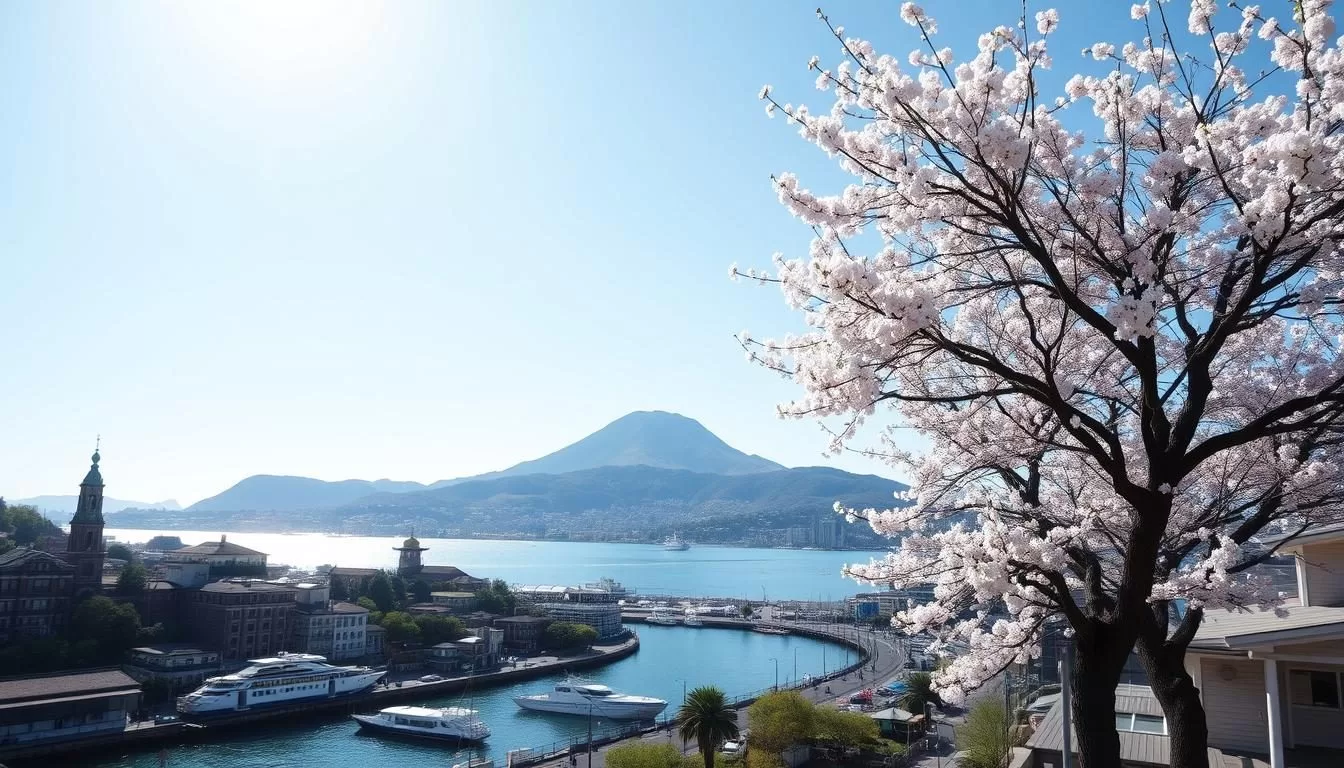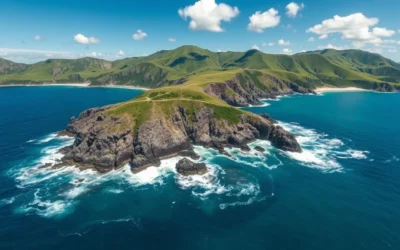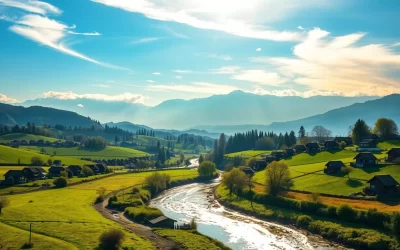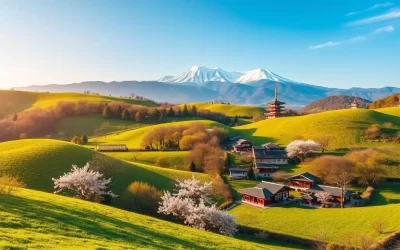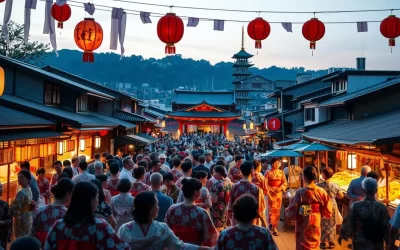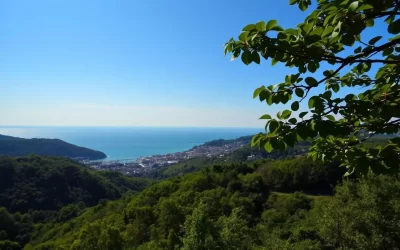Planning a trip to Nagasaki Prefecture can be a thrilling experience, given its rich history, vibrant culture, and stunning natural beauty. However, the prefecture’s weather varies significantly throughout the year, making the timing of your visit crucial.
Understanding the local climate patterns is key to enjoying your trip to the fullest. You’ll want to know when to expect pleasant temperatures, vibrant festivals, and minimal rainfall.
As you prepare for your trip, you’ll discover how the unique characteristics of each season can enhance your experience. From the beauty of cherry blossoms in spring to the excitement of summer festivals, time your visit right to make the most of your trip.
Understanding Nagasaki’s Climate
Visitors to Nagasaki experience a temperate climate with four distinct seasons, each offering a different charm. Nagasaki has a temperate climate with four seasons that bring different joys to those who visit.
Geographical Location and Its Impact on Weather
Nagasaki’s geographical location significantly influences its weather patterns. Situated on the western coast of Kyushu, one of Japan’s main islands, Nagasaki is exposed to the Asian continent’s climatic influences. Its proximity to the ocean moderates its climate, resulting in mild winters and warm summers.
The region’s topography, with its many islands and mountainous terrain, also plays a crucial role in shaping local weather conditions. This unique geography contributes to the varied experiences visitors have across different seasons.
Overview of Nagasaki’s Four Distinct Seasons
Nagasaki’s four seasons offer a diverse range of experiences for visitors. Spring brings renewal with cherry blossoms and comfortable temperatures, making it one of the most popular times to visit. The pleasant weather during spring allows for outdoor activities like hiking and sightseeing.
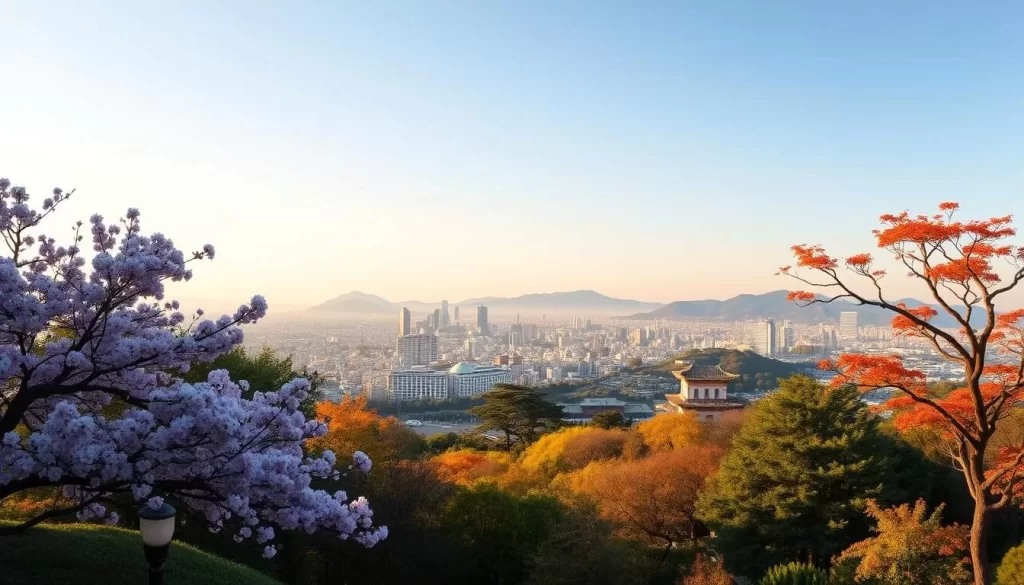
Summer is characterized by high humidity and temperatures, along with the rainy season and occasional typhoons. Despite the challenging weather, summer festivals and beach activities attract many visitors.
In autumn, the prefecture enjoys relief from summer’s heat with cooling temperatures and beautiful fall foliage throughout its parks and mountains. This season is ideal for nature lovers and those who enjoy outdoor activities.
Winter presents mild conditions compared to much of Japan, with rare snowfall and comfortable daytime temperatures that still allow for outdoor exploration. The mild winter weather makes it an attractive time for those who prefer fewer crowds.
| Season | Characteristics | Activities |
|---|---|---|
| Spring | Mild temperatures, cherry blossoms | Hiking, sightseeing |
| Summer | High humidity, rainy season, typhoons | Summer festivals, beach activities |
| Autumn | Cooling temperatures, fall foliage | Nature walks, outdoor activities |
| Winter | Mild temperatures, rare snowfall | Outdoor exploration, cultural events |
Spring in Nagasaki: March to May
Spring in Nagasaki, from March to May, is a season of renewal and celebration. During this period, the average temperature ranges from 52°F (11°C) to 68°F (20°C), making it an ideal time to explore the city’s many attractions.
Cherry Blossom Season: Timing and Best Viewing Spots
Nagasaki’s cherry blossom season typically occurs in late March to early April. Some of the best viewing spots include Mount Inasa and Peace Park, where you can enjoy the beautiful blooms.

Spring Temperatures and Precipitation Patterns
Spring in Nagasaki is characterized by mild temperatures and moderate precipitation. You can expect occasional rain showers, but the overall weather conditions are generally pleasant, making it a great time for outdoor activities.
Spring Festivals and Events
Nagasaki’s spring is not just about the weather; it’s also a time for vibrant festivals and events that showcase the city’s rich culture. One of the highlights is the Nagasaki Lantern Festival, which takes place in early spring and features thousands of colorful lanterns.
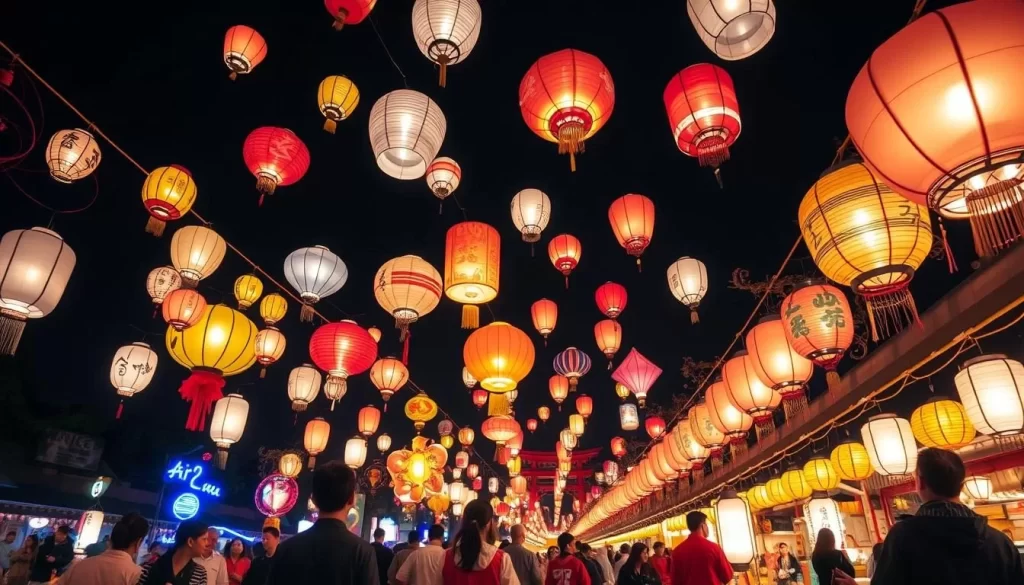
You’ll also have the opportunity to participate in local spring celebrations, which honor the changing season and agricultural traditions. Temple and shrine events during spring introduce you to the spiritual aspects of Japanese culture during this season of renewal.
To enhance your experience, be sure to check the local event calendars and join in the festivities. With a little preparation, you can fully immerse yourself in Nagasaki’s spring celebrations and create unforgettable memories.
Summer in Nagasaki: June to August
The arrival of summer in Nagasaki brings with it a mix of rain, heat, and exciting events. As you plan your trip, it’s essential to understand the different facets of Nagasaki’s summer.
Navigating the Rainy Season
Summer in Nagasaki begins with the rainy season, typically occurring in June. This period is characterized by frequent rain showers and high humidity. While it might seem gloomy, the rain brings a lush greenery to the city, making it a beautiful time for nature lovers. You can enjoy the serene landscapes and fewer tourist crowds during this time.
To make the most of your visit, consider packing waterproof gear and staying updated with weather forecasts. The rain also brings a unique charm to Nagasaki’s festivals, with some events taking place under the rain.
Heat and Humidity: What to Expect
As July and August roll in, Nagasaki experiences a significant rise in temperature and humidity. The hot weather is ideal for beachgoers and those who enjoy water activities. You can expect the temperatures to soar, often reaching above 30°C (86°F), accompanied by high humidity levels.
To beat the heat, locals often take breaks during the hottest part of the day and enjoy evening strolls or visits to local beaches. You can adopt similar strategies to enjoy your summer in Nagasaki, exploring the city’s cooler spots and participating in refreshing activities.
Summer Festivals and Beach Activities
Despite the weather, summer brings lively festivals and events to the city. Nagasaki is known for its vibrant summer matsuri, which showcase traditional dance, music, and food. One of the highlights is the Nagasaki Kunchi Festival, although it takes place in early fall, you can experience the summer festival spirit in various local events throughout June to August.
You can enjoy activities like swimming, sunbathing, and water sports at Nagasaki’s beautiful beaches. The evening events, including fireworks displays, offer a cooler and more relaxed experience. By immersing yourself in these local customs, you’ll have a more authentic summer experience in Nagasaki.
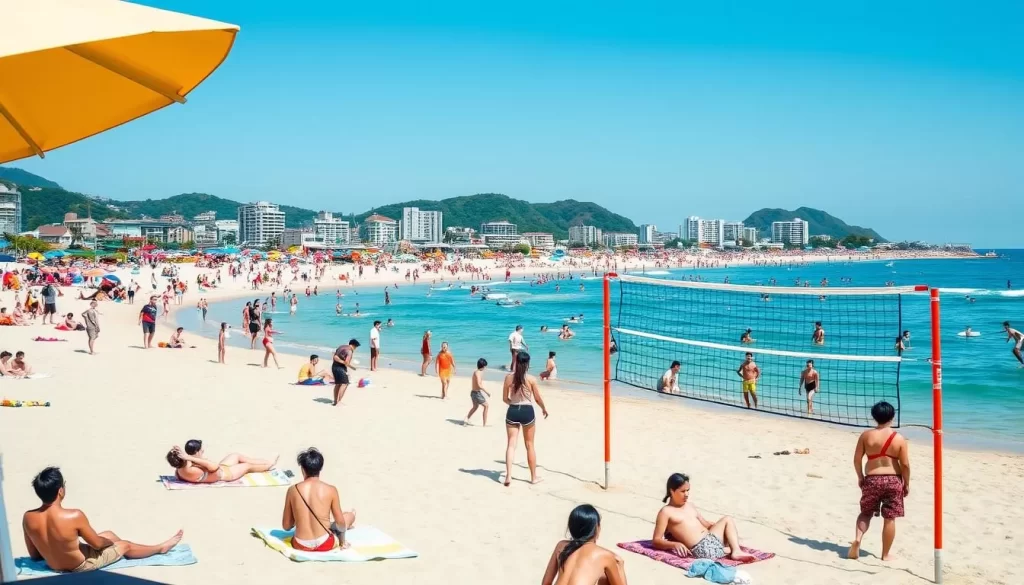
Autumn in Nagasaki: September to November
Autumn in Nagasaki, spanning from September to November, is a season of breathtaking natural beauty and cultural richness. As the summer heat begins to dissipate, the region transforms into a kaleidoscope of colors, accompanied by a variety of festivals and events that showcase the local culture.
Fall Foliage: When and Where to See It
Nagasaki’s autumn foliage is a major attraction, with numerous spots offering stunning views. Some of the best places to witness the fall colors include the Shimabara Peninsula, known for its maple trees, and the hills surrounding Nagasaki City, which provide a picturesque backdrop for hiking and photography.
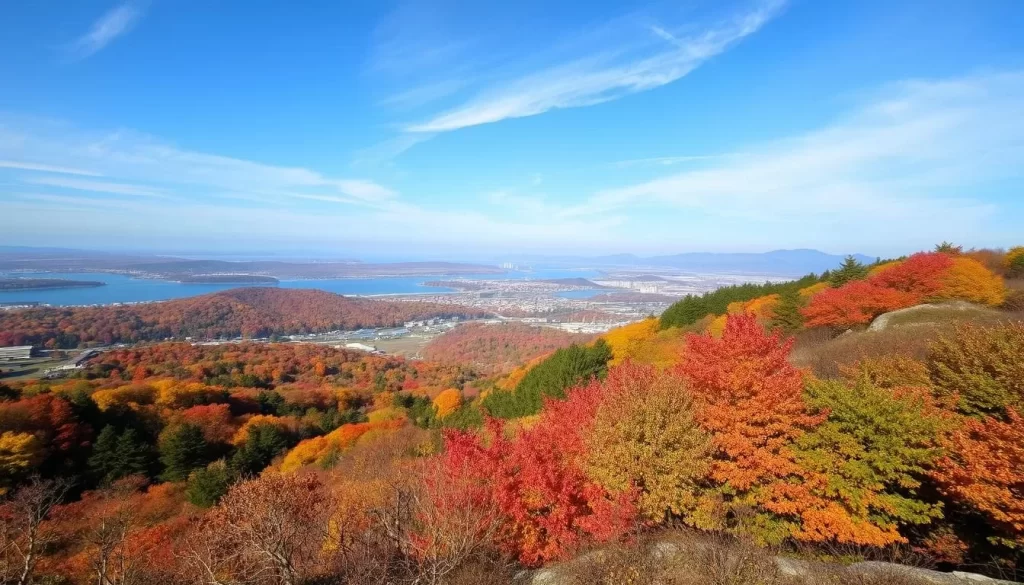
Autumn Weather Conditions
Autumn in Nagasaki is characterized by mild temperatures, with average highs ranging from 20°C to 25°C (68°F to 77°F). The weather is generally pleasant, making it an ideal time for outdoor activities such as hiking, sightseeing, and participating in local festivals.
Harvest Festivals and Cultural Events
Nagasaki’s autumn is not just about the fall foliage; it’s also a time for harvest festivals and cultural events. The region celebrates the season with various festivals and events that highlight the local culture. Visitors can enjoy traditional music, dance, and crafts specific to the Nagasaki region, as well as festival foods that showcase seasonal specialties.
One of the unique cultural events is the moon-viewing parties, or “tsukimi,” which honor the harvest moon. These events are a great way to experience the local culture and enjoy the autumn scenery. Additionally, food festivals during autumn introduce visitors to local culinary traditions and seasonal delicacies.
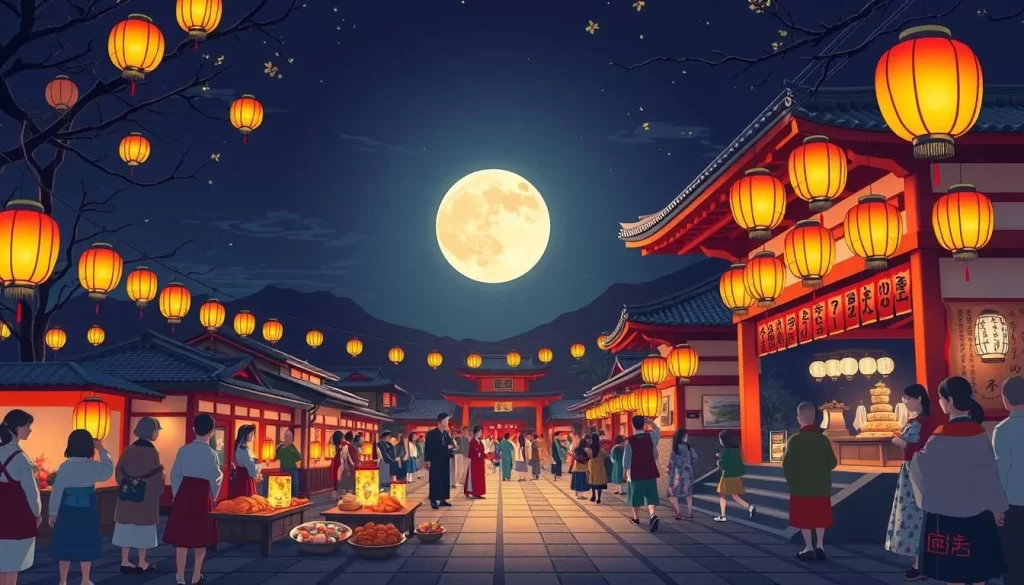
Participating in these activities as a foreign visitor can greatly enhance your cultural experience in Nagasaki during autumn. The region’s autumn celebrations offer a unique blend of traditional and modern elements, making it a fascinating time to explore Nagasaki.
Winter in Nagasaki: December to February
From December to February, Nagasaki presents a tranquil atmosphere, ideal for exploration. The mild winter weather, with average highs of 55°F (13°C) and lows of 42°F (6°C), makes it perfect for visiting outdoor attractions without the crowds.
Temperatures and Snowfall Patterns
Nagasaki’s winter is characterized by mild temperatures, making it an attractive destination for those who prefer cooler weather without the harshness of snow. While it can get chilly, especially in the mornings and evenings, the dry conditions make exploring the city’s outdoor historical sites and cultural attractions comfortable.
The snowfall in Nagasaki during winter is relatively light, with some areas receiving little to no snow. This makes it an ideal time for visitors who want to enjoy the city’s experience without the winter chill being too overpowering.
Illuminations and New Year Celebrations
Winter in Nagasaki is not just about the weather; it’s also a time for beautiful illuminations and New Year (Shogatsu) celebrations. Many parks and public spaces are adorned with stunning light displays, creating a magical atmosphere. The city’s illuminations are a must-see, offering a unique experience for visitors.
The New Year period is significant in Japan, and Nagasaki celebrates with traditional festivities. Visiting during this time allows travelers to immerse themselves in local culture and traditions.
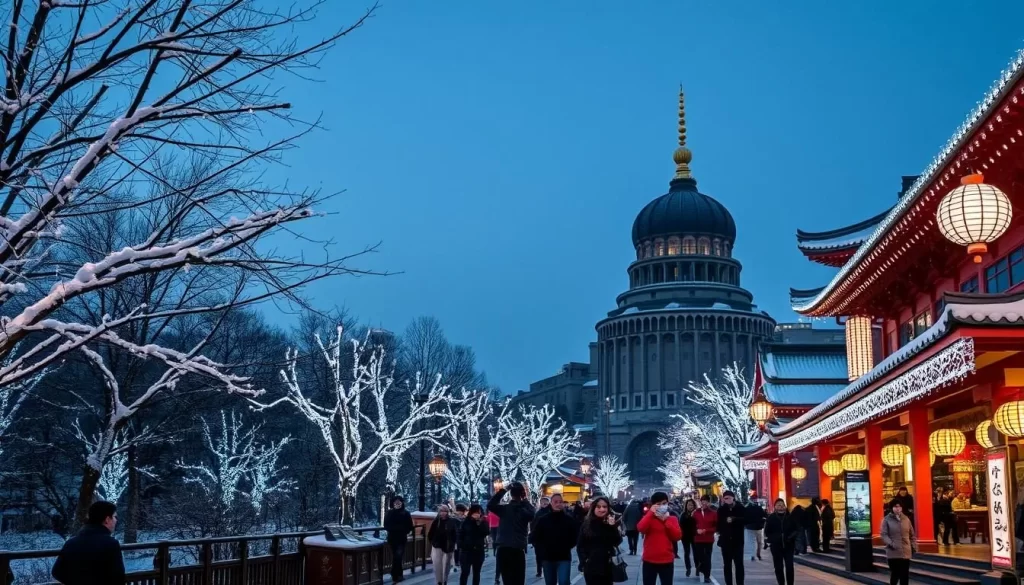
Off-Season Benefits for Travelers
One of the significant advantages of visiting Nagasaki during the winter off-season is the reduction in crowds at major attractions. This allows for a more intimate and peaceful experience of the city’s historical and cultural sites.
Moreover, travelers can benefit from substantial savings on accommodations and sometimes on transportation costs, making a trip to Nagasaki during winter a cost-effective option.
Nagasaki Prefecture, Japan: Best Months for a Weather-Savvy Trip
To make the most of your trip to Nagasaki, it’s essential to know the best months to visit based on weather preferences. Nagasaki Prefecture, located on the island of Kyushu, Japan, experiences a temperate climate with four distinct seasons, each offering unique attractions and activities.
April-May: Ideal for Cherry Blossoms and Mild Weather
Spring is a beautiful time in Nagasaki, with April and May being particularly pleasant. The cherry blossoms typically bloom in late March to early April, creating a picturesque landscape. During these months, the weather is mild, with average highs ranging from 18°C to 23°C (64°F to 73°F), making it ideal for outdoor activities like hiking and sightseeing.
October-November: Perfect for Fall Colors and Comfortable Temperatures
Autumn in Nagasaki is equally captivating, with October and November offering comfortable temperatures and stunning fall foliage. The autumn leaves, or “koyo,” typically peak in mid-to-late November, painting the landscape with vibrant colors. The weather during this period is generally cool and dry, with average highs between 18°C to 23°C (64°F to 73°F), making it perfect for exploring the city’s cultural and historical sites.
Weather Considerations for Different Types of Travelers
Different travelers have different preferences when it comes to weather. For instance, families with young children may prefer the mild weather of spring or autumn, while photography enthusiasts might be drawn to the dramatic skies of the rainy season or the serene landscapes of winter. Senior travelers or those with mobility concerns may appreciate the comfortable temperatures and minimal precipitation of spring and autumn.
| Traveler Type | Preferred Weather | Best Months |
|---|---|---|
| Families with Children | Mild Temperatures | April-May, October-November |
| Photography Enthusiasts | Dramatic Skies, Unique Landscapes | June-July (Rainy Season), December-February (Winter) |
| Senior Travelers or Those with Mobility Concerns | Comfortable Temperatures, Minimal Precipitation | April-May, October-November |
Understanding these preferences can help you plan your trip to Nagasaki more effectively, ensuring that your travel experience is both enjoyable and memorable. Whether you’re looking for the best time to visit Japan or seeking advice on how to make the most of your trip, considering the weather and your personal preferences is key.
Avoiding Peak Travel Seasons and Crowds
To make the most of your visit to Nagasaki, understanding the peak travel seasons is essential. Nagasaki, known for its historical significance and cultural richness, attracts tourists throughout the year. However, certain periods are busier than others due to local festivals and national holidays.
Golden Week
Golden Week, which takes place from late April to early May, is a significant holiday period in Japan. During this time, many Japanese people take vacations, leading to crowded tourist spots across the country. While Nagasaki is a popular destination, the crowds during Golden Week can be managed by planning ahead and visiting less crowded attractions.
You can enjoy the cherry blossoms and other spring festivities, but be prepared for larger crowds and potentially higher prices for accommodations.
Obon Festival
The Obon Festival, occurring in mid-August, is another peak travel period. It’s a time when families honor their ancestors, and many people return to their hometowns. While this can lead to crowded conditions in major cities, Nagasaki’s Obon Festival is also a unique cultural experience, featuring traditional dances and lanterns.
Visiting during Obon can be rewarding if you’re interested in Japanese culture and don’t mind the crowds. Planning your itinerary to include less crowded areas can help you navigate this busy period.
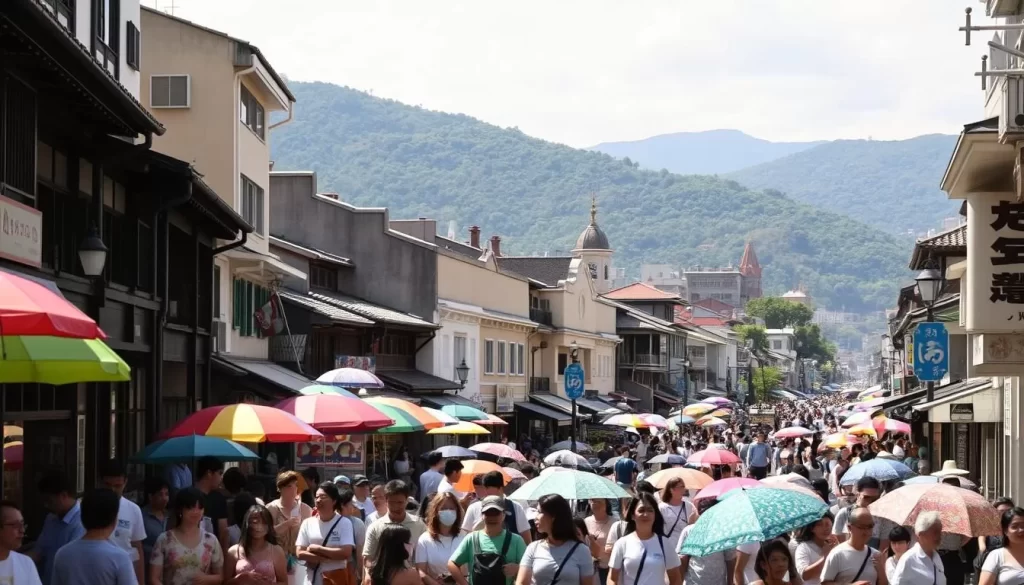
New Year Holidays
The New Year holidays, from late December to early January, represent a significant travel period in Japan. Many businesses close, and people travel to visit family or popular destinations, making major cities like Tokyo extremely crowded. However, Nagasaki might offer a more peaceful experience during this time, with some attractions and temples providing a serene atmosphere.
You can enjoy the New Year traditions and ceremonies at Nagasaki’s temples and shrines, which offer unique cultural experiences. Be aware that some attractions and businesses might be closed during the New Year holidays, so it’s wise to plan your itinerary accordingly.
By understanding these peak travel seasons, you can better plan your trip to Nagasaki, either by joining in the festive atmosphere or avoiding the crowds, depending on your preference.
Transportation Tips for Different Seasons
Understanding Nagasaki’s public transportation is key to a smooth trip. The city offers a comprehensive network that includes the JR Kyushu train system, buses, and trams, making it easy to get around.
Getting Around Nagasaki in Rainy Weather
During the rainy season, Nagasaki’s public transportation remains reliable. The JR Kyushu train system, buses, and trams continue to operate on schedule, ensuring you can visit all the major attractions without interruption. To make the most of your time, consider purchasing a prepaid IC card, which can be used across different modes of transport, making your journey smoother.
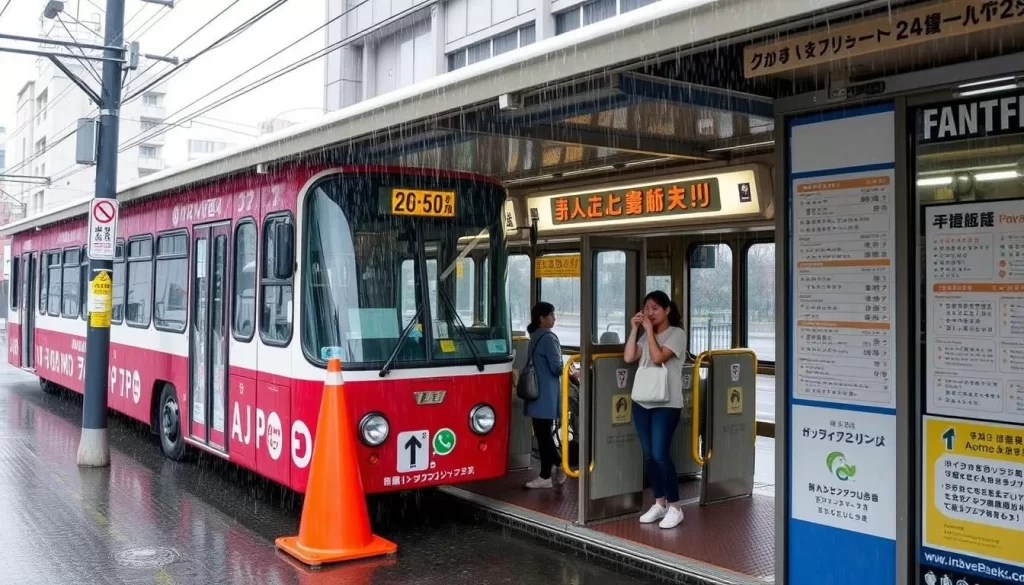
Transportation Options During Peak Tourist Seasons
During peak tourist seasons, such as cherry blossom season and autumn foliage, Nagasaki’s transportation systems can get crowded. To avoid long lines at ticket machines and counters, it’s advisable to purchase transportation passes in advance. The city’s efficient bus system is a great way to reach attractions outside the city center, and with some planning, you can navigate the routes even during the busiest periods.
Additionally, consider alternative transportation options like rental bicycles for exploring flatter areas of the city. Timing your travel to avoid rush hours and the busiest tourist periods will also make your experience more comfortable.
Key Transportation Tips:
- Plan Ahead: Understand how Nagasaki’s transportation systems handle increased passenger loads during peak seasons.
- Purchase Passes in Advance: Avoid long lines by buying your transportation passes early.
- Use the Bus System: Efficiently reach attractions outside the city center.
- Rental Bicycles: Explore flatter areas of the city with flexibility.
- Avoid Rush Hours: Time your travel for a more comfortable experience.
Accommodation Strategies by Season
Whether you’re visiting during peak bloom or off-peak months, Nagasaki has accommodation strategies to suit your needs. Planning your trip according to the season can significantly impact your experience, from the type of accommodation you choose to the activities you enjoy.
Where to Stay During Cherry Blossom Season
During cherry blossom season, Nagasaki becomes a hotspot for tourists. Booking your accommodation early is crucial to ensure a relaxed stay. Some of the best hotels for cherry blossom viewing include those with scenic views of the blossoms.
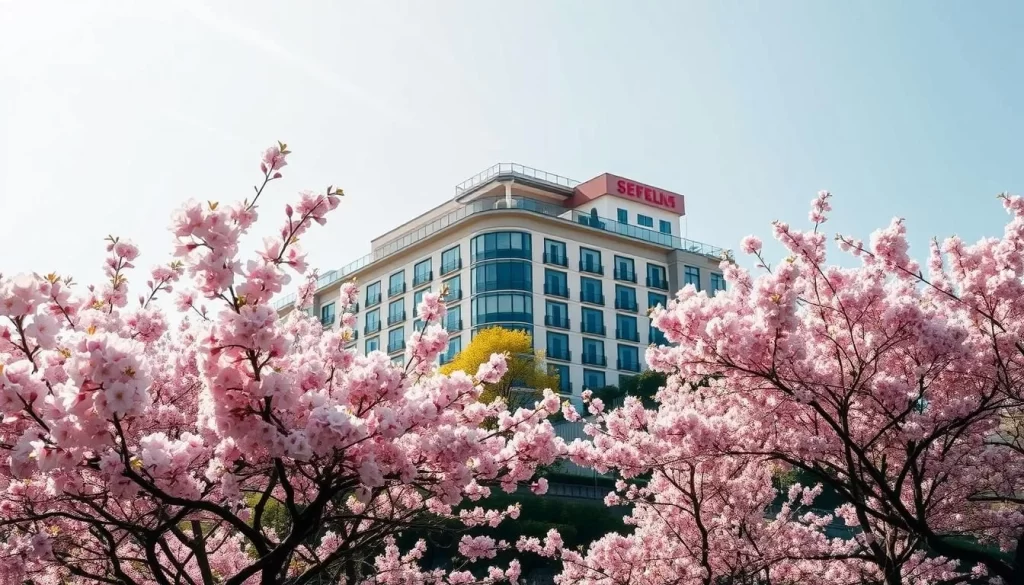
Budget Accommodations During Off-Peak Months
For travelers on a budget, Nagasaki offers a range of affordable accommodations during off-peak months, such as winter. You can find significant discounts on hotels, guesthouses, and hostels. Staying in less central locations can also provide better deals and easier access to main attractions due to fewer tourists.

Understanding how accommodation prices fluctuate with the seasons can help you plan your trip more effectively. By choosing to travel during off-peak months, you can enjoy budget-friendly options and a more relaxed atmosphere. It’s also worth considering winter promotions and extended-stay discounts to maximize your travel budget.
Packing Essentials for Each Season
To make the most of your trip to Nagasaki, it’s essential to understand what to pack for each season. Nagasaki’s climate varies significantly throughout the year, and being prepared will ensure a comfortable and enjoyable journey.
Spring Packing List
During spring (March to May), Nagasaki enjoys mild temperatures, making it an ideal time to visit. You should pack layers for your trip, including light jackets and sweaters for cooler mornings and evenings. Comfortable walking shoes are a must, as you’ll likely explore the city’s many historical sites and scenic spots. Don’t forget to include an umbrella or raincoat, as spring showers are common.
Summer Essentials and Rainy Season Gear
Summer in Nagasaki (June to August) is characterized by hot and humid weather, with a rainy season that typically occurs in June and July. Pack lightweight, breathable clothing to stay cool, and include a waterproof jacket or poncho to prepare for sudden rain showers. Sunglasses, sunscreen, and a hat are also essential for protecting yourself from the sun.
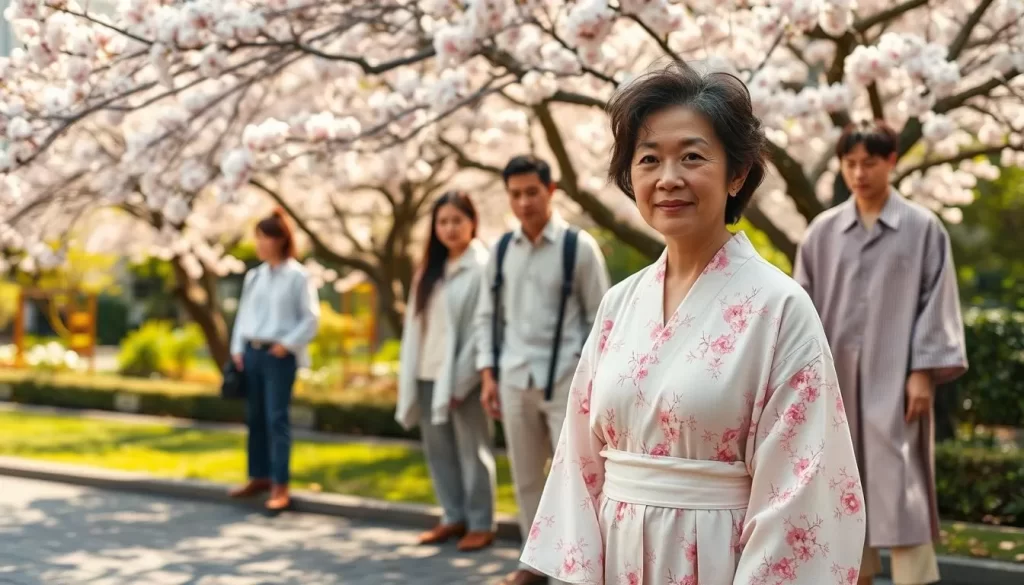
Autumn Clothing and Accessories
Autumn (September to November) brings comfortable temperatures to Nagasaki, making it another excellent time to visit. You can expect mild days and cooler evenings, so packing layers is again advisable. Include a light jacket or sweater for the cooler mornings and evenings, and comfortable shoes for exploring the city’s autumn foliage.
Winter Warmth: What to Bring
Winter in Nagasaki (December to February) can be cool, especially in the mornings and evenings. While it’s not as cold as northern Japan, you’ll still need to pack for the cold weather. A medium-weight coat, along with sweaters and long-sleeved shirts that can be layered, will provide the necessary warmth. Don’t forget accessories like gloves, scarves, and hats to keep you comfortable during outdoor exploration. For the occasionally wet conditions, a good pair of walking shoes with non-slip soles is recommended. Additionally, consider packing lip balm and moisturizer to combat the dry winter air.
Top Attractions in Nagasaki and Best Times to Visit Them
When planning your trip to Nagasaki, understanding the best times to visit its top attractions can significantly enhance your travel experience. Nagasaki, with its rich history and diverse landscapes, offers a variety of experiences for visitors throughout the year.
Historical Sites: Peace Park and Atomic Bomb Museum
The Nagasaki Peace Park and Atomic Bomb Museum are poignant reminders of the city’s history. Visiting these sites can be a somber experience, and it’s worth considering the weather and tourist seasons when planning your visit. The best time to visit is during the spring (March to May) or autumn (September to November), when the weather is mild and conducive to a reflective visit.
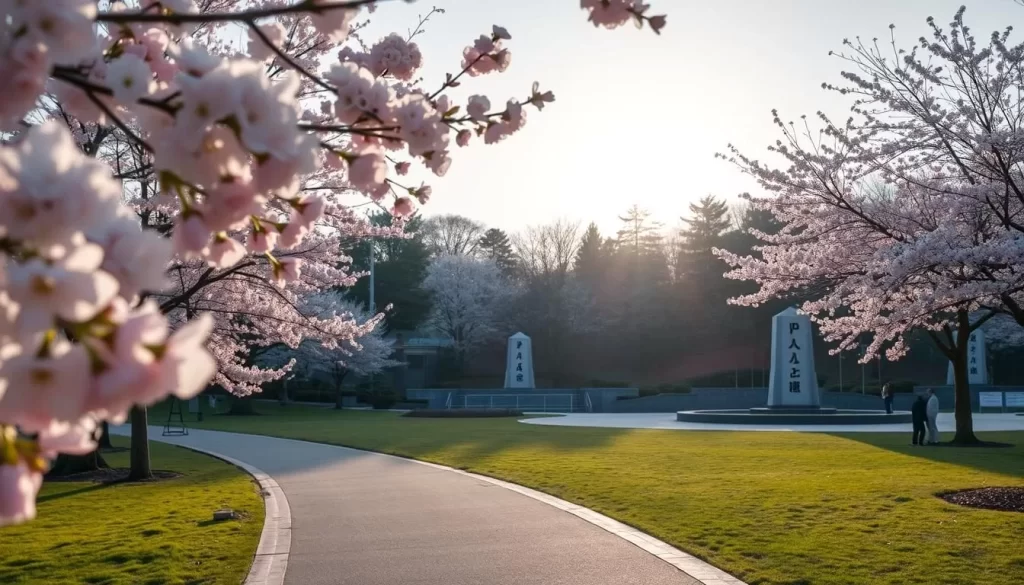
These periods avoid the peak summer heat and the cold winter months, making your visit more comfortable. The Peace Park, with its statues and memorials, is particularly beautiful during the cherry blossom season, adding a layer of serenity to your visit.
Glover Garden and Dutch Slope
Glover Garden, showcasing the lifestyle of a British merchant from the 19th century, is another must-visit attraction. The garden is especially beautiful during the spring and autumn seasons when the flowers are in bloom or the foliage changes colors. The contrast between the historic buildings and the natural beauty surrounding them is a treat for visitors.
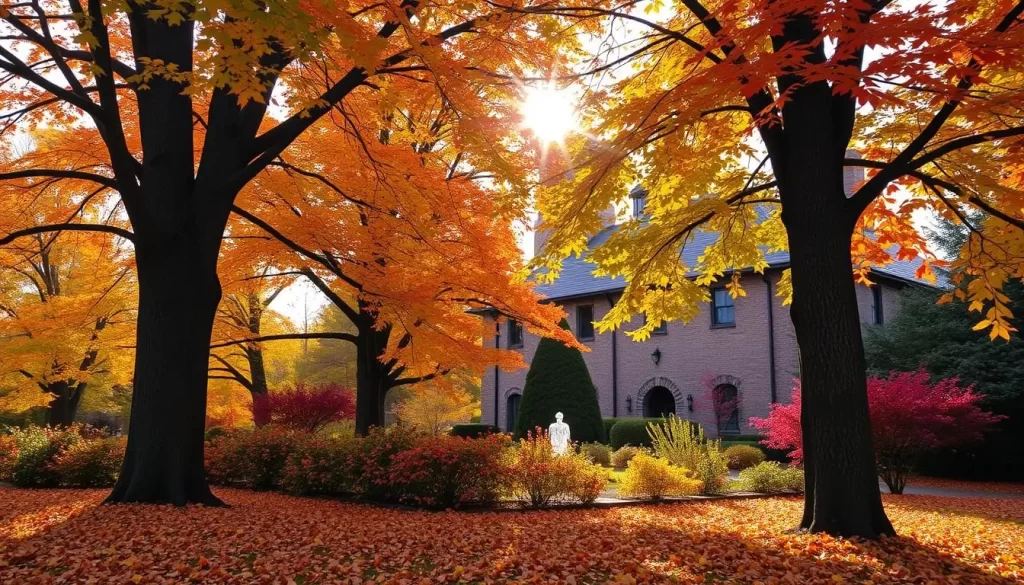
Visiting during the less crowded months can provide a more intimate experience with the history and culture on display. The Dutch Slope, with its charming streets and architecture, complements the Glover Garden visit, offering a glimpse into Nagasaki’s international past.
Mount Inasa and Nagasaki Ropeway
Mount Inasa is renowned for its night views, considered one of Japan’s three best. The Nagasaki Ropeway provides easy access to the summit. For the best experience, visit during the sunset to witness the transition from daylight to the spectacular night view.
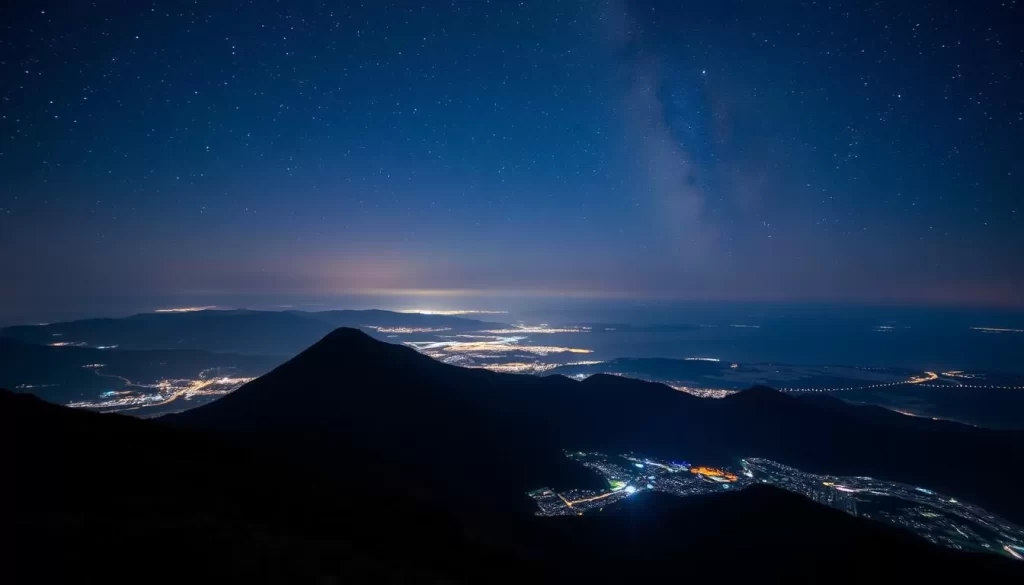
It’s advisable to check the operating hours of the ropeway, as they vary seasonally, and plan your visit on clear days to ensure the best visibility. Avoiding peak tourist seasons and weekends will also make your visit more enjoyable.
In conclusion, Nagasaki’s attractions offer a wide range of experiences that can be enjoyed throughout the year. By planning your visits according to the seasons and weather conditions, you can have a more fulfilling and memorable trip.
Day Trips from Nagasaki: Seasonal Considerations
The areas around Nagasaki offer a plethora of attractions that are perfect for day trips, each with its own seasonal charm. Whether you’re interested in history, nature, or entertainment, there’s something for everyone. You can explore abandoned islands, enjoy scenic landscapes, or visit theme parks, all within a day’s journey from Nagasaki city.
Hashima Island (Gunkanjima): Best Visiting Conditions
Hashima Island, commonly known as Gunkanjima, is a fascinating destination that offers a glimpse into Japan’s industrial past. The best time to visit is during the spring or autumn when the weather is mild and comfortable for walking tours around the island. You can explore the abandoned buildings and streets, getting a unique insight into the lives of the people who once lived and worked there.
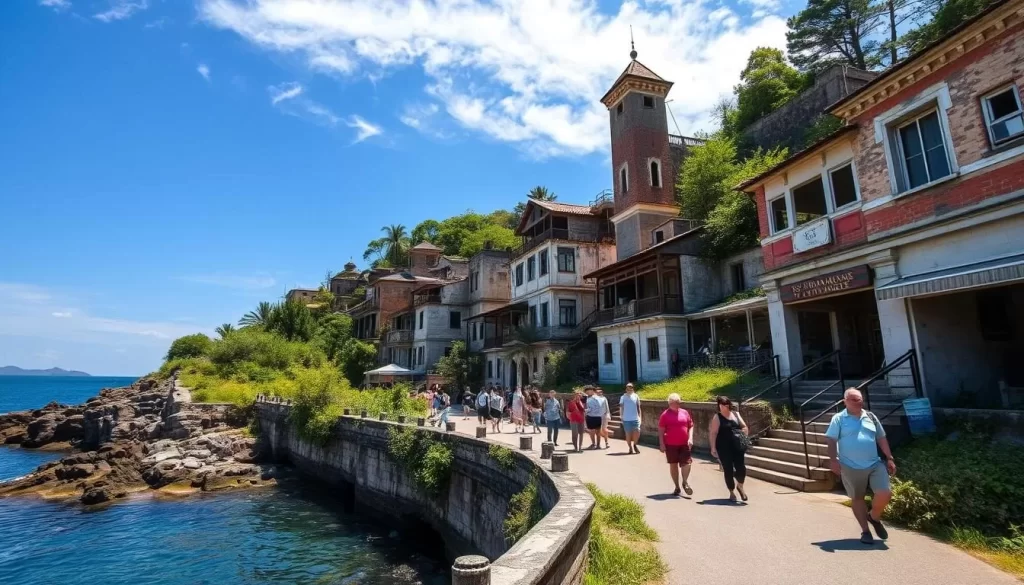
Shimabara Peninsula and Mount Unzen
The Shimabara Peninsula is another great day trip destination, known for its natural beauty and historical significance. Mount Unzen, an active volcano, offers hiking opportunities with breathtaking views. The area is particularly beautiful during the spring when cherry blossoms bloom or in autumn when the foliage changes colors. You can enjoy hot springs, scenic drives, and historical sites, making it a well-rounded day trip.
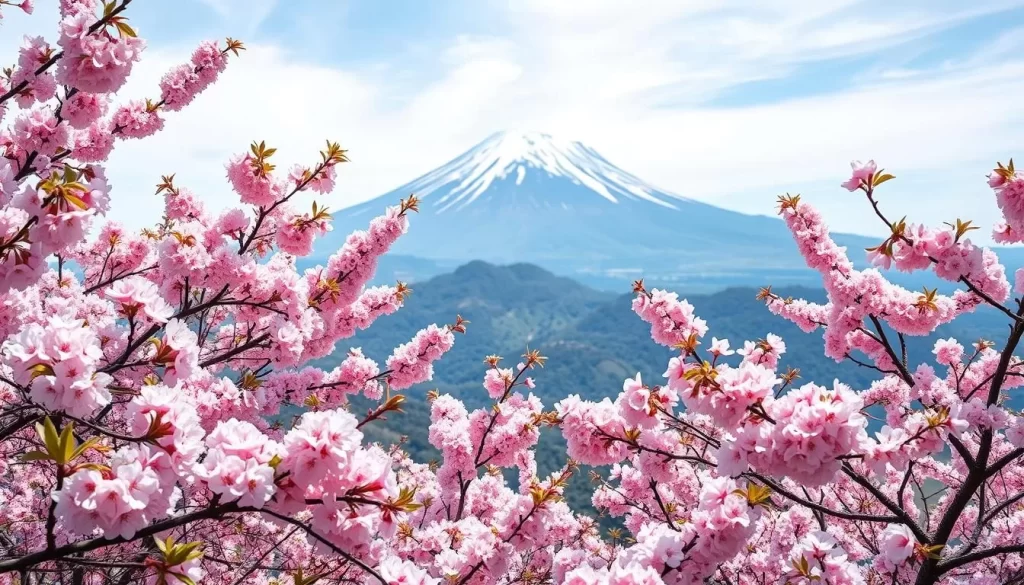
Huis Ten Bosch Theme Park
If you’re looking for a more leisurely day trip, Huis Ten Bosch Theme Park is a great choice. This park recreates a Dutch town on a massive scale, complete with canals, windmills, and European-style architecture. You can enjoy the park’s seasonal transformations, from tulips in spring to spectacular illuminations in winter. It’s a great place to relax and enjoy some family-friendly fun. Visiting on weekdays can help you avoid the crowds.
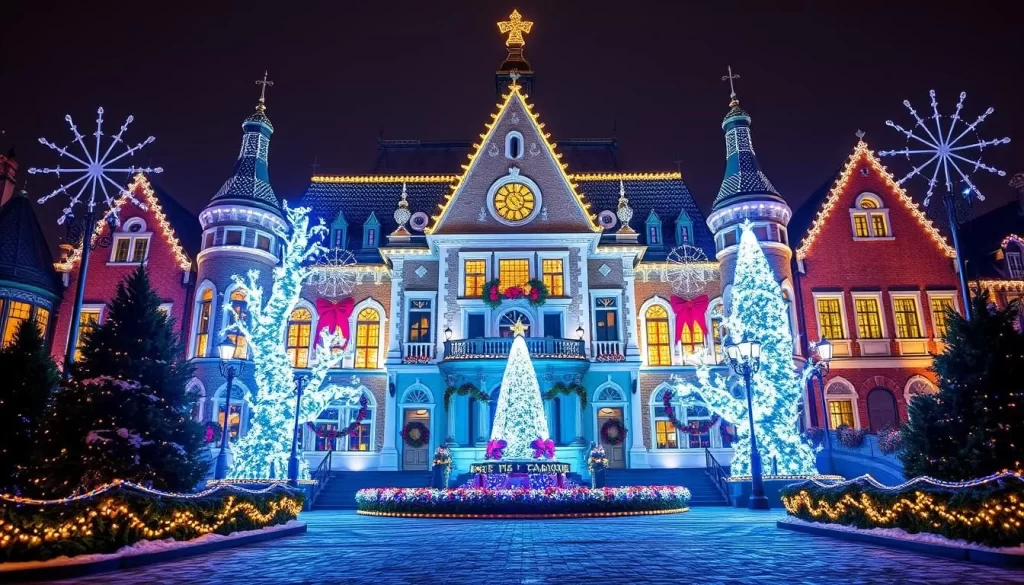
Each of these day trips offers a unique experience, showcasing the diversity of attractions around Nagasaki. By planning your visits according to the seasons, you can make the most of your trip and enjoy the best that the area has to offer.
Nagasaki’s Culinary Delights by Season
Nagasaki’s cuisine is a reflection of its rich cultural heritage, with each season bringing its own unique flavors and dishes. As you explore the local culinary scene, you’ll discover a variety of traditional and modern dishes that showcase the region’s history and cultural influences.
Spring and Summer Specialties
In the spring, Nagasaki’s markets are filled with fresh produce, including seasonal vegetables and fruits that are used in a variety of dishes. Summer brings its own set of specialties, with an emphasis on seafood and cooling treats to combat the heat. You can enjoy local delicacies such as fresh sushi and sashimi, as well as traditional summer foods like kakigori, a shaved ice dessert flavored with syrup.
During this time, you should also try some of the region’s unique spring and summer food offerings, which highlight the best of Nagasaki’s agricultural produce and seafood.
Autumn and Winter Comfort Foods
As autumn arrives, Nagasaki’s culinary scene shifts towards heartier dishes, incorporating the season’s bounty of mushrooms and other ingredients into traditional recipes. This makes for a great time to visit for food lovers, as the local cuisine becomes even more comforting and flavorful.
In winter, the focus is on comfort foods that warm the soul. You can indulge in Nagasaki beef dishes and various hot pot variations that are perfect for the cooler temperatures. The city’s unique cultural heritage is also reflected in special winter treats like castella, a Portuguese-influenced sponge cake that has become a local favorite.
During the seasonal seafood peak in colder months, you’ll find the freshest and most flavorful options on restaurant menus, making it an ideal time to enjoy Nagasaki’s seafood delicacies.
For a cozy respite from the winter weather, visit one of Nagasaki’s traditional tea houses or cafes, where you can enjoy local specialties in a warm and welcoming atmosphere.
Photography Tips for Nagasaki’s Changing Seasons
With its rich history and natural beauty, Nagasaki is a city that transforms with the seasons, offering endless photography possibilities. As you explore this fascinating city, understanding the unique characteristics of each season will help you capture its essence.
Capturing Cherry Blossoms and Spring Scenery
Spring in Nagasaki is a magical time, with cherry blossoms blooming across the city. To capture the beauty of this season, focus on the soft light of early morning or late afternoon. The gentle colors of spring provide a serene backdrop for your photographs.
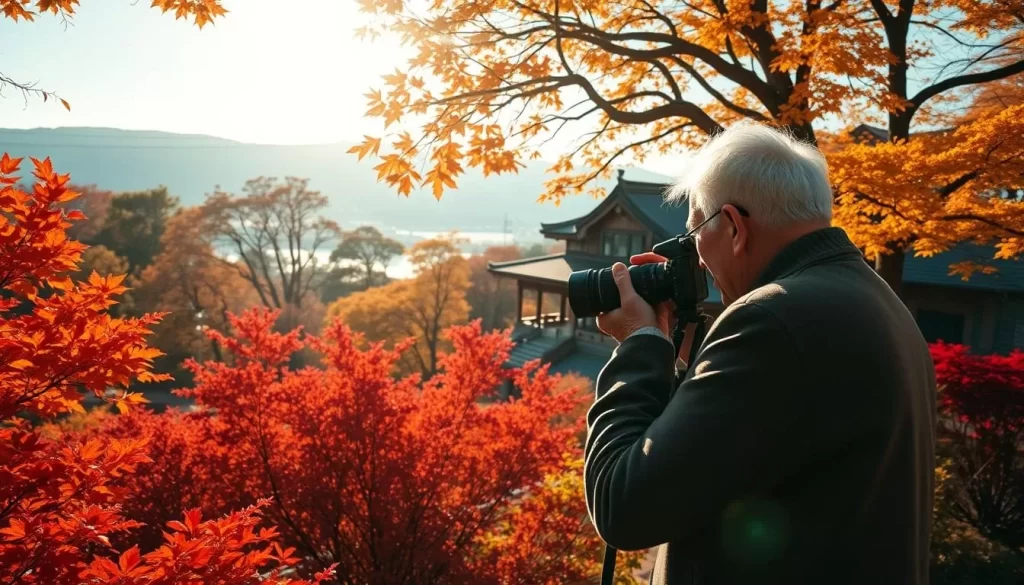
Autumn Colors and Winter Landscapes
Autumn brings vibrant foliage, while winter offers serene landscapes. For autumn colors, take advantage of the clear skies and comfortable temperatures to capture the rich hues. In winter, the soft, diffused light can add a mystical quality to your photographs, especially during the early morning or late afternoon.
Best Times of Day for Photography in Different Seasons
The best time for photography varies by season. In summer, the early morning light is ideal for avoiding harsh shadows. In winter, the midday light can be surprisingly flattering. Don’t miss the “golden hour” just before sunset, which enhances Nagasaki’s historical architecture in any season. Night photography opportunities abound, with seasonal illuminations and the famous night views from Mount Inasa.
Weather-Related Challenges and How to Overcome Them
To make the most of your trip to Nagasaki, it’s vital to understand the weather-related challenges you might face and how to overcome them. Nagasaki’s climate can be quite varied, with different seasons bringing unique conditions that can impact your travel plans.
Dealing with Typhoon Season
Typhoon season in Nagasaki typically occurs from late summer to early fall. During this time, it’s crucial to stay informed about weather forecasts and be prepared for potential disruptions. Consider having a flexible itinerary and staying in touch with local weather updates.
Some attractions might be closed or have limited access during typhoons, so it’s a good idea to identify indoor activities that can be enjoyed instead. Nagasaki has a variety of museums and historical buildings that are perfect for visiting on rainy days.
Coping with Summer Humidity
Summer in Nagasaki is characterized by high temperatures and humidity. To cope with these conditions, make sure to stay hydrated by drinking plenty of water and take regular breaks in shaded or air-conditioned areas.
Wear light, breathable clothing and comfortable shoes to help manage the heat and humidity. This will make your exploration of Nagasaki’s outdoor attractions more enjoyable.
Rainy Day Activities and Backup Plans
On rainy days, Nagasaki offers several indoor activities that can be a great alternative to outdoor sightseeing. The Nagasaki Museum of History and Culture and the Dejima Dutch Trading Post are excellent choices, providing a glimpse into the city’s rich history and cultural heritage.
You can also explore covered shopping arcades and department stores, which offer a dry and comfortable environment for shopping and dining. Additionally, consider participating in indoor cultural experiences such as tea ceremonies or cooking classes, which provide a unique and engaging way to spend a rainy day.
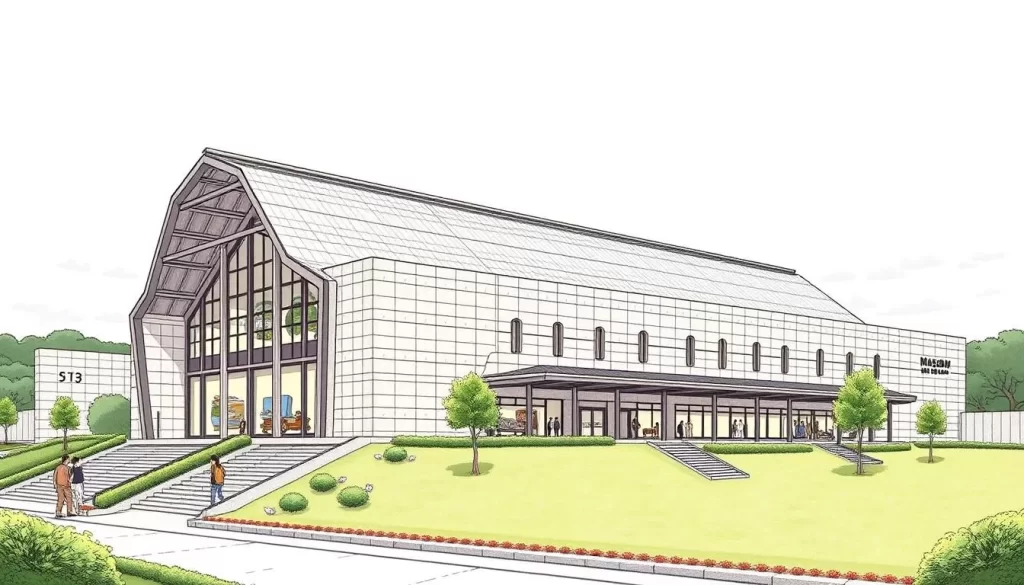
Conclusion
Nagasaki Prefecture, with its distinct seasons, invites you to experience its beauty in various ways. As you’ve gathered from this article, each time of the year brings its unique charm and attractions.
You’ve gained comprehensive insight into Nagasaki’s seasonal variations and can now confidently choose the best time for your visit based on your weather preferences and interests. The article has equipped you with practical strategies for navigating each season’s unique challenges and opportunities.
From cherry blossom viewing in spring to coping with summer humidity, you’re now well-prepared. You’ve also learned about the special seasonal attractions, festivals, and culinary experiences that make each time of year in Nagasaki distinctive and memorable.
Whether you choose the mild temperatures of spring and autumn or embrace the distinctive character of summer or winter, you’re ready to plan a weather-savvy trip to Nagasaki Prefecture. This historically rich and naturally beautiful destination promises to create lasting memories for you.
By avoiding crowds during peak travel periods and finding value during off-seasons, you can enjoy a more relaxed and budget-friendly trip to this fascinating part of Japan. So, pick your preferred time to visit and get ready for an unforgettable adventure.
The above is subject to change.
Check back often to TRAVEL.COM for the latest travel tips and deals.
